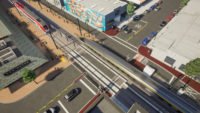After California’s new governor, Gavin Newsom (D), restated the priorities of his state’s high-speed rail project, and later clarified his views further, realists looking for good news about the project let loose with an affirming “Amen.”
Instead of turning his back on the entire venture and abandoning his state’s transportation future, as many opponents of the project had hoped, Newsom faced up to the realities of spiraling costs.
He set a more achievable initial goal, the 117-mile segment currently under construction in the Central Valley, as the first priority. He acknowledged the problems and risks in the originally envisioned 300-mile version, with branches. He did not try to put an arrow through the the original San Francisco-to-Anaheim plan’s heart. As a reader points out in a comment below this editorial, the state legislature is the only authority that can change the plan. Newsom is still going to build a fully Proposition 1A compliant downtown SF-Anaheim line with a trip time under 180 minutes. He just did not express this correctly in his speech.
Estimation shortcomings and scope creep give critics ammunition to attack public works, but the benefits of finished projects help quiet the critics.
The dishonor of trying to kill high-speed rail in California belongs to President Donald Trump, whose administration’s empty promises on infrastructure have taken a distant back seat to other priorities. His Dept. of Transportation announced that it is actively seeking every legal way to force California to return the $2.5 billion the federal government previously granted for what it termed this “now-defunct project,” citing its lack of progress and cost overruns. The real reason appears to be that California is among 17 states to file a lawsuit blocking the administration’s emergency declaration, which would clear the way for a funds transfer to build a border wall. The Transportation Dept.’s actions bear the stamp of Trump’s ire.
Nevertheless, the project has legitimate issues. The California High-Speed Rail Authority underestimated the messy land acquisitions, and a $63.6-million change order had to be paid because of those delays. But the main problem is that the publicly disclosed estimated costs proved too low. So although the overall project was framed with a grand vision of stitching together distant hubs and enlivening underdeveloped areas, high-speed rail’s opponents have been able to reduce the issue to one of short-term financial returns. Ignoring the bigger picture, they talk about the low comparative cost of auto and air travel.
Transparency is what’s needed now to reassure the public on scope and costs. The high-speed rail authority should continue with its own honest updating of realistic costs estimates and examine other issues, such as links between stations and any local transit. At the governor’s request, the authority recently added copies of all change orders to the project website.
Estimation shortcomings and scope creep give critics ammunition to attack public works. An example is Boston’s Central Artery/Tunnel, nicknamed the Big Dig. Despite a final cost many times higher than originally estimated, in the end, the benefits of uniting Greater Boston and easing traffic helped quiet the critics. And who doubts we won’t be able to say the same thing about California high-speed rail? Remember, another California public works project faced fierce criticism and relentless enemies—the Golden Gate Bridge.
Editor's note: The first version of this editorial was based on Gov. Newsom's original, somewhat confusing account of his views of California's high-speed rail project. This editorial was corrected March 13 to reflect his clarified position on his intention to connect Anaheim and San Francisco while initially concentrating on the Merced to Bakersfield section. It was also corrected to show that state lawmakers have the final say in enacting the rail system they were instructed to build by voters who approved Proposition 1A.



Post a comment to this article
Report Abusive Comment